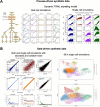Towards multi-omics synthetic data integration
- PMID: 38711370
- PMCID: PMC11074586
- DOI: 10.1093/bib/bbae213
Towards multi-omics synthetic data integration
Abstract
Across many scientific disciplines, the development of computational models and algorithms for generating artificial or synthetic data is gaining momentum. In biology, there is a great opportunity to explore this further as more and more big data at multi-omics level are generated recently. In this opinion, we discuss the latest trends in biological applications based on process-driven and data-driven aspects. Moving ahead, we believe these methodologies can help shape novel multi-omics-scale cellular inferences.
Keywords: data-driven; machine learning; multi-omics; process-driven; synthetic data.
© The Author(s) 2024. Published by Oxford University Press.
Figures

References
-
- Servia-Rodriguez S, Wang L, Zhao J, et al. Privacy-Preserving Personal Model Training. In: 2018 IEEE/ACM Third International Conference on Internet-of-Things Design and Implementation (IoTDI), Orlando, FL, IEEE, NJ, USA, 2018, 153–64.

